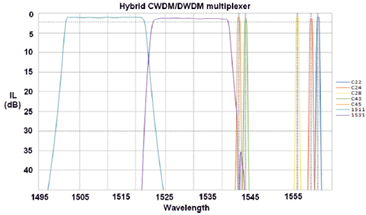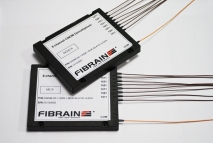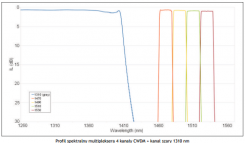Fibrain family of CWDM solutions (Coarse Wavelength Division Multiplexing), based on TFF (Thin Film Filter) technology, incudes OADM devices and MUX/DMUX modules. The series of CWMD devices has a high interchannel isolation, low attenuation, and a flat passband profile. They are available in an outdoor version designed to withstand temperatures in the -40/+85 °C range, also in hermetic housings. These devices are designed for multiplexing of existing fiber optic paths.
OADM devices (Optical Add/Drop Multiplexers) are used for separating (DROP) and adding (ADD) chosen channels without terminating the other, transit channels in the link. By using OADMs, it is possible to connect CWDM systems into a point-to-multipoint or ring topology. Unlike the classical MUX/DMUX module, the OADM has two linear interfaces (marked as east and west) and from two to eight local interfaces, which allows for building more complicated topologies.
MUX/DMUX modules built into terminals are used for multiplexing existing fiber optic links. They decrease the number of components in a link since they eliminate the need to install new fiber optic cables. They are most often used in 4-, 8-, and 16-channel versions with the possibilities of upgrading with additional functions.
CCWDM devices (Compact CWDM) are appliances that have smaller dimensions and ultra-low insertion losses comparing to traditional CWDM filters. They are recommended mostly for applications with extremely tight power budget.
CWDM transmission is often used in metro networks, where the signal quality is extremely important and the operators cannot be at risk at lowering it. This is why all Fibrain CWDM components are measured in all spectral range and delivered with reports that show the whole spectral profile, so the values of attenuation and isolation given in the report are always “worst case.”| Type | 1270, 1290,..,1610 or 1271,1291,...,1611 | ||
| Number of channels | 1ch | 2ch | 3ch |
| Ch. isolation | 20 nm | ||
| Ch. width | Λc +/- 6.5 | ||
| Passband ripple | ≤ 0.4 dB | ||
| Add/Drop ch. attn. | ≤ 0.6 dB | ≤ 1.0 dB | ≤ 1.7 dB |
| Express ch. attn. | ≤ 0.6 dB | ≤ 1.2 dB | ≤ 2.0 dB |
| Adjacent ch. isolation | ≥ 30 dB | ||
| Nonadjacent ch. isolation | ≥ 40 dB | ||
| Express ch. isolation | ≥ 25 dB | ||
| Directivity | > 55 dB | ||
| RL | >50 dB | ||
| PDL | ≤ 0.1 dB | ||
| Band thermal stability | 0.003 nm/ 0C | ||
| Attn. thermal stability | 0.005 nm/ 0C | ||
| Input power | 500 mW | ||
| Temp. of operation | from -0 to 700C | ||
| Temp. of storage | from -40 to 850C | ||
Notice: Parameters listed in the table refer to components without connector terminations.
| Type* | 4 ch. | 8 ch. | 16 ch. | |
| Attenuation [dB] | ≤ 2.0 | ≤ 3.5 | ≤ 4.5 | |
| Wavelengths [nm] | 1270, 1290,..,1610 or 1271,1291,...,1611 | |||
| Channel isolation | 20 nm | |||
| Channel width [nm] | Λc +/- 6.5 | |||
| Passband ripple | ≤ 0.4 dB | |||
| Band uniformity | ≤ 1.0 dB | |||
| Adjacent ch. isolation | ≥ 30 dB | |||
| Nonadjacent ch. isolation | ≥ 40 dB | |||
| Directivity | > 55 dB | |||
| RL | > 50 dB | |||
| PDL [dB] | 0.15 | 0.20 | ||
| PMD [ps] | 0.10 | 0.15 | ||
| Band thermal stability | 0.003 nm/ 0C | |||
| Attn. thermal stability | 0.005 nm/ 0C | |||
| Input power | 500 mW | |||
| Temp. of operation | from -0 to 700C | |||
| Temp. of storage | from -40 to 850C | |||
* versions with other numer of CWDM channels are also available.
Notice: Parameters listed in the table refer to components without connector terminations.
Additional ports:
- Test 1310 +/- 50 nm,
- Monitoring 1/99%,
- Upgrade 1260-1457 nm,
- Upgrade 1460-1610 nm.
| Type | 4 ch. | 8 ch. | 18 ch. | |
| Attenuation [dB] | ≤ 1.6 | ≤ 1.8 | ≤ 1.8 typ. (2.5 max) | |
| Wavelengths [nm] | 1270, 1290,..,1610 lub 1271,1291,...,1611 | |||
| Channel isolation | 20 nm | |||
| Channel width | Λc +/- 6.5 | |||
| Passband ripple | ≤ 0.4 dB | |||
| Band uniformity | ≤ 1.0 dB | |||
| Test port | 1310 +/- 50 nm | |||
| Monitoring port | 1/99% | |||
| Adjacent ch. isolation | ≥ 30 dB | |||
| Nonadjacent ch. isolation | ≥ 40 dB | |||
| Upgrade port isolation | ≥ 15 dB | |||
| Directivity | > 55 dB | |||
| RL | > 50 dB | |||
| PDL [dB] | 0.15 | 0.20 | ||
| PMD [ps] | 0.10 | |||
| Band thermal stability | 0.003 nm/ 0C | |||
| Attn. thermal stability | 0.005 nm/ 0C | |||
| Input power | 500 mW | 300 mW | ||
| Temp. of operation | from -0 to 700C | |||
| Temp. of storage | from -40 to 850C | |||
Notice: Parameters listed in the table refer to components without connector terminations.
Besides standard options, i.e. separating or adding single CWDM channels, the multiplexers can be specialized and adapted to customer's needs.
Additional finctionalities:
- Power monitoring port
- grey 1310 nm port
- HI/LO filters
- OSC/DWDM filters
- OTDR monitoring port
- Upgrade port allowing future link expansion.
- High thermal stability of parameters
- Available in outdoor versions and hermetic housings
- Low insertion and polarization losses
- High channel isolation
- Wide range of availble housings and connectors
- Nonstandard solutions with specialized functionalities available
- CWDM systems
- Add/Drop solutions
- Telecommunication networks
- Optical amplifiers
- CATV systems

- Products
- Optical Splitters and Couplers
- WDM Multiplexers and Filters
- CWDM Multiplexers and Filters
- CWDM Filters
- OADM Devices and MUX/DMUX Modules
- CWDM Modules in LGX Casings
- CWDM Modules in PZCW Casings
- DWDM Multiplexers and Filters
- xWDM/xPON Multiplexers
- Optical Isolators and Circulators
- Fiber Attenuators
- Special Passive Devices
- Measuring Equipment and Accessories


